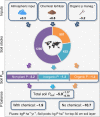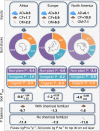Global phosphorus shortage will be aggravated by soil erosion
- PMID: 32917863
- PMCID: PMC7486398
- DOI: 10.1038/s41467-020-18326-7
Global phosphorus shortage will be aggravated by soil erosion
Abstract
Soil phosphorus (P) loss from agricultural systems will limit food and feed production in the future. Here, we combine spatially distributed global soil erosion estimates (only considering sheet and rill erosion by water) with spatially distributed global P content for cropland soils to assess global soil P loss. The world's soils are currently being depleted in P in spite of high chemical fertilizer input. Africa (not being able to afford the high costs of chemical fertilizer) as well as South America (due to non-efficient organic P management) and Eastern Europe (for a combination of the two previous reasons) have the highest P depletion rates. In a future world, with an assumed absolute shortage of mineral P fertilizer, agricultural soils worldwide will be depleted by between 4-19 kg ha-1 yr-1, with average losses of P due to erosion by water contributing over 50% of total P losses.
Conflict of interest statement
The authors declare no competing interests.
Figures




References
-
- Bouwman, A. F., Beusen, A. H. W. & Billen, G. Human alteration of the global nitrogen and phosphorus soil balances for the period 1970-2050. Global Biogeochemical Cycles23, 1-16, 10.1029/2009gb003576 (2009).
-
- Carpenter SR, Bennett EM. Reconsideration of the planetary boundary for phosphorus. Environ. Res. Lett. 2011;6:1–12. doi: 10.1088/1748-9326/6/1/014009. - DOI
-
- Cordell D, Drangert JO, White S. The story of phosphorus: global food security and food for thought. Glob. Environ. Change. 2009;19:292–305.
-
- Gilbert N. Environment: the disappearing nutrient. Nature. 2009;461:716–718. - PubMed
-
- Edixhoven JD, Gupta J, Savenije HHG. Recent revisions of phosphate rock reserves and resources: a critique. Earth Syst. Dynam. 2014;5:491–507.
Publication types
LinkOut - more resources
Full Text Sources
Other Literature Sources
Research Materials

